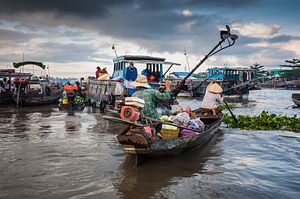A two-day meeting in Laos regarding the construction of a 260-megawatt dam on the Lower Mekong River has predictably done little to close the gap between the Lao government, which is intent on proceeding with the project, and other parties that remain concerned over its environmental and geopolitical impacts, Voice of America reported Tuesday.
The proposed Don Sahong hydropower project is critical part of the Lao government’s hopes to transform the country into “the battery of Southeast Asia,” with revenues generated from exporting power to neighboring countries. But the other three neighboring countries in the lower Mekong – Thailand, Cambodia and Vietnam – have joined with rights groups in formally calling for a halt in construction to allow for further impact studies. They argue that the proposed project would dramatically alter the flow of the Mekong River and disrupt the migration of fish to the detriment of downstream communities in neighboring countries.
“The likely impacts from the Don Sahong dam…pose an unacceptable risk to food security, lives and livelihoods and the health of millions of people,” the Save the Mekong Coalition wrote in the Vietnamese publication Thanh Nien News on Friday ahead of the meeting.
Cambodia, Laos, Thailand and Vietnam are all bound by a 1995 Mekong treaty to hold inter-governmental consultations before constructing new dams, and the recent meeting was part of this process. However, Laos continues to insist that it only needs to notify its neighbors about its desire to build the dam, and it has already begun constructing it.
Meanwhile, governments and groups from neighboring Thailand, Vietnam and Cambodia have said that the trans-boundary impacts of the dams mean that the wisdom of the project itself needs to be debated first, or else the consultation process itself would be of limited utility.
“Construction has begun and decisions have already been made, prior to any “consultation” taking place. The process will simply serve as a ritual or a rubber stamp for the dam,” Somkiat Khuenchiangsa, coordinator of the Thailand-based Chiang Kong Conservation Group and the Mekong-Lanna Network on Cultural and Natural Resources Conservation said in an op-ed to The Bangkok Post on December 11.
The effects of the Don Sahong dam on neighboring countries could be significant. The dam will block the only channel available for dry-season fish migration, leading to the demise of important fisheries and the potential extinction of critically endangered Irrawaddy dolphins, which are also a big source of eco-tourism.
Disrupted fish migration patterns would be particularly devastating for Cambodia, since more than 70 percent of protein consumed there comes from fish. The dam would also affect the roughly 20 million residents of Vietnam’s Mekong Delta, which accounts for more than a quarter of the country’s GDP. An expected drop in alluvium would render soil unsuitable for cultivation, while drought and salination will be more severe, potentially disrupting the livelihoods of millions and leading to an employment and migration crisis for the Vietnamese government.
“The dam will come like a hit to the back of the head. It will be a fatal blow,” Dr. Duong Van Ni from Can Tho University said.
The consequences could extend into the geopolitical arena as well. Carlyle Thayer, a political scientist with the Australian-based University of New South Wales (and Diplomat regular), told Voice of America that if the dam affects the livelihood of farmers in the Mekong Delta as predicted, it could then generate bottom-up pressure and affect bilateral relations between Laos and Vietnam.
“It’s going to test [Communist] party to party relations between Laos and Vietnam quite severely. And also a bad time for Laos because Vietnam has got one more year to the party congress and there’s a plenum to do with pretty strident nationalism in Vietnam,” Thayer said.
Yet Lao officials have insisted on going forward with the dam. They say that the Mekong River Commission cannot stop the country from pursuing its right to hydropower, and that the Lao government and the dam’s developers are working to address some of the environmental concerns raised. However, critics remain unconvinced that the mitigation measures proposed will be sufficient.
“[T]he Lao government will not be deterred from its commitment to develop clean, renewable hydropower, a source of national pride for the Lao people and a sustainable source of electricity for the region,” Viraphonh Viravong, the country’s vice minister of energy and mines, wrote in an especially strident op-ed in Thailand’s Nation newspaper in late October.
Following this round of regional consultations, additional discussions are expected to take place before a decision is reached on the project in early 2015.

































